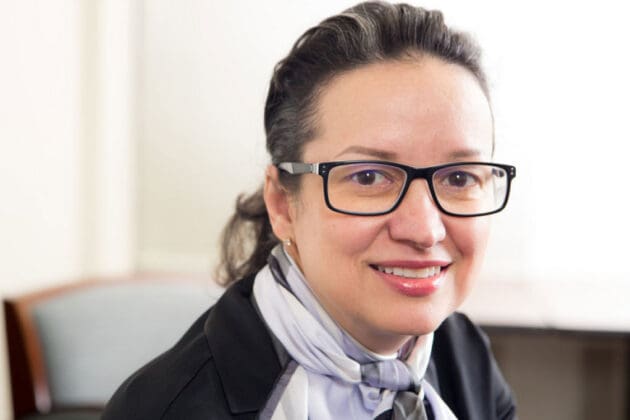
The elderly gentleman had just lost his wife and, sadly, was facing the end of life. He came from a culture that didn’t see the benefits of hospice care, but longtime VNS Health nurse Nancy Girlando carefully and compassionately introduced the idea to the man and his adult son early on in the father’s care. When the family decided on hospice for their loved one, Nancy saw relief in their eyes, knowing their father would be cared for and comforted in his final days — and that the family would also receive the support and services they needed to help get them through this difficult time.
At the time, Nancy was working with a new nurse. In the eyes of this new nurse, Nancy saw a sense of inspiration and amazement at what the new nurse’s profession could bring to people’s daily lives.
Inspiring a new generation of nurses and other caregivers has never been more essential than it is today. The United States faces a dramatic shortage of health care workers, especially nurses and home health aides. The U.S. Bureau of Labor Statistics projects that our aging population will need nearly 925,000 new home health aides over the next decade. Even before the COVID-19 pandemic, BLS projected that the U.S. would require more than 203,000 new RNs every year through the next decade to meet need. The pandemic accelerated the imbalance in supply and demand, with an overburdened frontline workforce reporting record levels of burnout and many leaving the field.
I recently spoke with Nancy and her VNS Health RN colleague Nicole Casiano to learn what lessons and inspirations they impart to — and learn from — the next generation of nurses. Nancy and Nicole are nurse preceptors for VNS Health, which means they provide hands-on, in-field training to nurses new to home care. As a result, they are uniquely positioned to outline the incomparable rewards of being a caregiver, especially one who delivers home care.

You see the fruits of your labor in real time
Because she introduced the end-of-life conversation early in her patient’s care, Nancy and the nurse she was training were able to see the family embrace the peace and quality of life that hospice delivers. This reinforced one of Nancy’s greatest rewards as a home care nurse: you can see the outcomes of your treatment and care in real time and in real lives.
Rewards come in many different forms, says Nicole. “It might be a very sick patient whose goal is to be able to go to a holiday function at their daughter’s house. Then, with your care, they are able to get to that activity — and they’re so happy. We’re happy, too, because the patient’s successes are our successes as nurses.”
Or your patient might be faced with a troublesome wound that keeps them from activities of daily life — a wound that, with your skilled intervention, begins to heal. The new skin closing around the wound is a literal picture of the change you’ve made in a life.
You transform quality of life, day in and day out
icole tells new nurses: “You may not be able to cure diabetes, but you can transform how a person lives with the illness going forward.” You can help people with diabetes stay healthy by eating the right foods at the right time, monitoring blood glucose levels, and staying physically active. Or you might enable a person with COPD (chronic obstructive pulmonary disease) to breathe easier by helping them manage their medications, whether delivered orally or inhaled; create the best environment, which is cool and dry; and understand the symptoms of their illness and when to call for extra help.
Home health aides (HHAs) also provide vital support to the most vulnerable — often transforming lives through their empathy and compassion. VNS Health HHA Marie Dorvilne changed her client’s negative thinking and kept her from pitching into a downward emotional spiral by putting on some music from the internet and encouraging her client to dance with her. And Marie’s ability to spot problems and connect her client to a doctor’s care has saved the day many a time, putting her client on the path to better health.
You empower people to help themselves

With more than half of American adults living with a chronic illness and nearly 25 percent living with more than one such condition, it is more important than ever for people to learn to manage chronic illness at home. As a caregiver, you can play a critical role here.
Nicole loves to hear her patients say, “No one ever told me that before.” She heard those words recently from a woman with heart failure and her son after educating them on disease management. Nicole and a nurse trainee taught the mother and her son how to check her weight every day, watch her extremities for fluid retention, closely monitor breathing, and follow a healthy diet. “They were astounded at all we taught them,” Nicole said, adding that she believes clinicians probably informed the pair on these points in the hospital, but people are often more receptive to hearing the information once they get home and back to their lives.
Nicole emphasizes to her trainees that patients and family members receive information in many different ways. “Say it and write it down,” she enumerates. “I’ve made charts and signs for patients as well. We use many tools to get the point across, innovating to create solutions. There no such thing as over-communicating.”
You get to know — and heal — people in the full context of their lives
Life is lived at home, where people are surrounded by family and friends — not in a doctor’s office or the hospital. As a home care provider, you have the advantage — and honor — of going into people’s homes and seeing their lives firsthand, deepening your understanding of what they need on the most basic level. Do they have food in the refrigerator? Have they been taking their medicines? Do they have a support system… air-conditioning during a heat wave… a scale to weigh themselves?
Through active listening and careful observations, you can hear and see more than what your patient is telling and showing you. They may say they are eating well or taking their medicine properly, but you may discover otherwise when you find a nearly empty refrigerator or a full bottle of medication. Or, in contrast, they may tell you that they cannot get out of bed, walk across the room, or do their physical therapy exercises. But with your compassion and encouragement, you may well find that in fact they can do it.
As a final note to new caregivers, Nancy and Nicole emphasize that nurses — particularly those in home care — need to know more than skills and tasks. They also need to harness innovative problem-solving, active listening, empathy, and compassion. “It’s not enough to be trained in changing catheters and doing wound care,” says Nancy. “There so much else that goes into it.” That includes educating and empowering patients to take care of themselves; healing in partnership with your patients; and meeting people where they are, with humanity and hope.
This article was originally posted on Medium. You can view it here.



